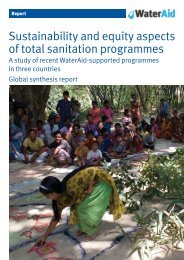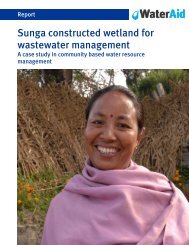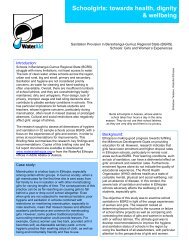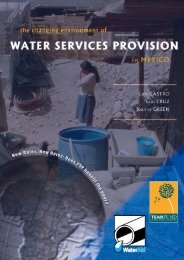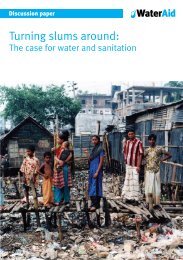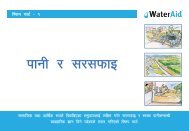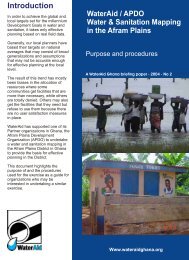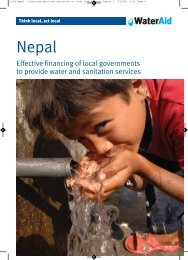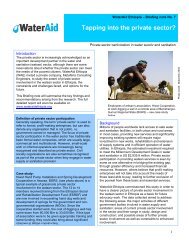Community participation issue sheet - WaterAid
Community participation issue sheet - WaterAid
Community participation issue sheet - WaterAid
Create successful ePaper yourself
Turn your PDF publications into a flip-book with our unique Google optimized e-Paper software.
<strong>Community</strong> <strong>participation</strong><br />
<strong>WaterAid</strong> – water for life<br />
The UK’s only major charity<br />
dedicated exclusively to<br />
the provision of safe<br />
domestic water, sanitation<br />
and hygiene education to<br />
the world’s poorest people<br />
<strong>Community</strong> <strong>participation</strong><br />
<strong>WaterAid</strong>/Abir Abdullah<br />
<strong>Community</strong> <strong>participation</strong> is vital to all of <strong>WaterAid</strong> and its partners’ projects. By communities<br />
being involved in all stages, from the planning through to the building and managing, of their<br />
water, sanitation and hygiene schemes, long term solutions can be found that are suited to<br />
their own needs, preferences and resources.<br />
Rather than being imposed by outsiders, projects should solve the communities’ own<br />
problems in a way that is appropriate and manageable for them. With a detailed<br />
understanding of the how and why of their water supply, sanitation and hygiene facilities<br />
communities will be committed to their projects and feel a sense of ownership for them.<br />
Ultimately community <strong>participation</strong> is all about enabling communities to help themselves.<br />
By utilising their own skills and resources communities are able to take their first steps out<br />
of poverty. And once these basic services are in place and communities develop the skills<br />
and resources for changing their environment they continue to further their development.
Issue <strong>sheet</strong>: <strong>Community</strong> <strong>participation</strong><br />
Getting started<br />
While community <strong>participation</strong> is vital in all<br />
phases of <strong>WaterAid</strong>’s projects it is especially<br />
crucial at the beginning during the planning and<br />
decision making processes. <strong>WaterAid</strong>’s initial<br />
introduction to a community is usually through<br />
village leaders, elders or influential people. They<br />
then call the whole community together in a large<br />
meeting for everyone to hear about the project.<br />
<strong>WaterAid</strong>/Caroline Penn<br />
As it is often easier for women<br />
and less powerful community<br />
members to talk in smaller<br />
focus groups, household<br />
meetings or individually, field<br />
workers make sure they reach<br />
these people by setting up<br />
smaller, more appropriate<br />
meetings.<br />
Working with communities<br />
is a two-way process. Project<br />
staff and villagers work<br />
together and learn from each<br />
other. Through discussions<br />
and meetings the community<br />
identify their needs in terms of<br />
water supply, sanitation and<br />
hygiene and share their<br />
knowledge of the local<br />
environment and resources.<br />
<strong>WaterAid</strong>’s partners then<br />
discuss the range of technical<br />
solutions possible in their<br />
situation together with<br />
information about the costs<br />
and the type of service these<br />
options provide. At this stage<br />
community members can often<br />
visit other similar projects and<br />
learn from the experiences of<br />
other communities. This<br />
information then enables them<br />
to make informed choices<br />
about their future water and<br />
sanitation facilities.<br />
The community then<br />
decides on the type of project<br />
it needs, where the project<br />
should be based, how much it<br />
can afford to spend and what<br />
each family should contribute.<br />
A crucial part of the planning<br />
stage is ensuring that the<br />
projects are appropriate to<br />
everyone in the community<br />
and that poorer families can<br />
still afford to benefit from the<br />
schemes. So, while<br />
communities share the costs of<br />
projects by making appropriate<br />
labour, time or financial<br />
contributions to the initial and<br />
long-term running costs, the<br />
levels or type of contributions<br />
depend upon what families<br />
and individuals can afford.<br />
People who are disabled,<br />
elderly or simply unable to<br />
contribute are subsidised by<br />
those who are better off.<br />
“People are prepared to<br />
pay money to use the latrines<br />
as they know the funds pay to<br />
keep the latrines clean. If<br />
people are unable to pay, for<br />
instance if they are sick,<br />
disabled or are a lady living<br />
alone, then we let them in for<br />
free.” Mrs Lakshmi,<br />
Karuvattupettai slum, India.<br />
In Nigeria <strong>WaterAid</strong> and its<br />
partners developed a system to<br />
ensure each member of the<br />
community contributes fairly.<br />
This system ranks community<br />
members’ levels of poverty<br />
according to indicators which<br />
they suggest themselves.<br />
Examples include the size and<br />
type of house they live, and the<br />
materials it is made of,<br />
possessions, livestock, clothing<br />
and schooling. A community’s<br />
ranking determines their<br />
eligibility for support and the<br />
level of subsidy they are given.<br />
This system is just one of<br />
a range of participatory<br />
techniques and tools that field<br />
workers and community<br />
members use to plan and<br />
monitor the work. Knowledge<br />
and information is accessible<br />
to both literate and illiterate<br />
people by using diagrams,<br />
maps and pictures.<br />
Constructing and<br />
running the projects<br />
<strong>Community</strong> members<br />
undertake the construction<br />
work of wells and latrines by<br />
digging and collecting<br />
materials such as sand and<br />
stones, and breaking rocks<br />
down in to gravel. They also<br />
provide timber and build<br />
fences around water points to<br />
protect them from pollution<br />
from animals.<br />
Individuals are appointed<br />
by their community to manage<br />
the project and accounts,<br />
often through a water<br />
committee which oversees the<br />
day-to-day maintenance and<br />
collection of water fees where<br />
these are charged. They<br />
receive training from <strong>WaterAid</strong><br />
and its partners so that they<br />
are equipped to run their<br />
projects in the long term.<br />
Communities are responsible<br />
for the regular maintenance<br />
and servicing of their water<br />
and sanitation facilities which<br />
means they are self reliant<br />
and only call out engineers if<br />
they have a serious problem.<br />
In many countries villagers<br />
volunteer to attend training<br />
courses and become health<br />
education workers. Local<br />
people are best situated to<br />
make decisions about which<br />
hygiene messages are a<br />
priority for their community<br />
and the best ways in which<br />
these should be told.<br />
Finally, the community is<br />
also involved in monitoring<br />
progress and in evaluating the<br />
project once it is completed.<br />
The results, and communities’<br />
solutions to problems, help to<br />
improve <strong>WaterAid</strong>’s work and<br />
build community confidence<br />
to plan other development<br />
activities for themselves.<br />
The success of all the work<br />
is dependent on the<br />
communities making the level<br />
of input necessary for a scheme<br />
to keep functioning for years to<br />
come. Such commitment will<br />
only come if their wishes have<br />
been respected, they have<br />
been given adequate<br />
information to make informed<br />
choices, have enough training<br />
for on-going maintenance and<br />
they feel a sense of ownership<br />
of their project.<br />
Who is involved?<br />
<strong>WaterAid</strong> projects seek to<br />
involve all members of the<br />
communities that they work<br />
with. Within each community<br />
there are individuals, each with<br />
their own interests and<br />
priorities. There will be men,<br />
women and children, leaders<br />
and people with different levels<br />
of wealth and of different caste,<br />
religions and ages. The biggest
Issue <strong>sheet</strong>: <strong>Community</strong> <strong>participation</strong><br />
challenge of any project is to<br />
ensure that all community<br />
members are involved,<br />
particularly the poorest and<br />
least powerful, so that<br />
everyone, especially the most<br />
vulnerable, benefit equally.<br />
Women are key participants<br />
in successful projects. They<br />
place a high priority on water<br />
supply and so <strong>WaterAid</strong>’s<br />
partners work to ensure that<br />
they are consulted about their<br />
preferences for project design<br />
and where the projects should<br />
be sited. Their knowledge<br />
about water sources is<br />
particularly valuable, for<br />
example, in identifying where<br />
the nearest, cleanest water<br />
sources are and at which time<br />
of year they might dry out.<br />
Involving women also has a<br />
positive impact on their<br />
position in the community. By<br />
having such an important and<br />
public role as a health<br />
promoter or a water committee<br />
member, women’s skills in the<br />
community are enhanced.<br />
Ultimately new skills bring<br />
more confidence enabling<br />
them to become stronger and<br />
more respected.<br />
“Since we have had the<br />
new water source life has<br />
changed in so many amazing<br />
ways. My status as a woman<br />
has now been finally<br />
recognised. When I stand up<br />
now in a group meeting I am<br />
not an animal. I am a woman<br />
with a valid opinion.”<br />
Nakwetikya, Ndedo village in<br />
the Kiteto region of Tanzania.<br />
<strong>WaterAid</strong>/Alex Macro<br />
<strong>WaterAid</strong> programmes<br />
always include hygiene<br />
education and in this area<br />
children have proved<br />
invaluable. Hygiene education<br />
is often given through<br />
schools. Children are more<br />
open to discuss and change<br />
hygiene habits than adults<br />
whose behaviour has been<br />
ingrained over a lifetime.<br />
Children who learn the<br />
importance of good hygiene<br />
practices will pass these on to<br />
their families, younger<br />
brothers and sisters and<br />
ultimately their own children.<br />
Caste is also a challenge<br />
which <strong>WaterAid</strong> aims to<br />
address within its programme<br />
work. In India and Nepal,<br />
where this is a particular<br />
<strong>issue</strong>, <strong>WaterAid</strong> attempts to<br />
help break barriers imposed<br />
by caste systems by ensuring<br />
that people within the lower<br />
castes, who are normally<br />
discriminated against, have an<br />
equal standing within projects<br />
as those of a higher caste.<br />
<strong>WaterAid</strong>/Martin Argles<br />
“I used to feel very inferior.<br />
I was afraid. But after learning<br />
mechanical skills I started<br />
talking to the upper-caste<br />
villagers. When they installed a<br />
borewell I offered to help them.<br />
Some of them didn’t want me<br />
to touch the well. But in the<br />
end they agreed.” Durga Rao,<br />
23, a lower caste dalit, was<br />
trained by <strong>WaterAid</strong>’s partner<br />
SVDS as the handpump<br />
mechanic in Seetanagaram<br />
village, Andhra Pradesh.<br />
The keys to community <strong>participation</strong><br />
● Participation involves joint planning and<br />
self-analysis<br />
● Men and women, of all levels of wealth in<br />
the community are involved in decision<br />
making and receive equal training<br />
opportunities<br />
● Local people’s knowledge and views are<br />
actively sought<br />
● <strong>Community</strong> members explain their<br />
priorities and identify available skills,<br />
resources and appropriate contributions to<br />
the project. This process motivates people<br />
to take action to bring about changes in<br />
their lives<br />
● The involvement of local people from the<br />
outset ensures that projects are more<br />
responsive to communities’ needs,<br />
resources and abilities<br />
● By putting time, effort and savings into<br />
a scheme, communities will be more<br />
determined to maintain it<br />
● Local people are trained to manage and<br />
maintain their water and sanitation<br />
services<br />
● Water committees are formed to ensure<br />
that tariff rates, spare parts and<br />
mechanical costs, as well as the quality<br />
and frequency of maintenance, are kept at<br />
a suitable level
Case studies:<br />
<strong>WaterAid</strong>/Somesh<br />
<strong>Community</strong> sanitation funds<br />
<strong>WaterAid</strong>’s partner REEDS has recently<br />
helped the Chilamalamailaream villagers<br />
in the Mahabubnagar District of India to<br />
form self help groups, construct latrines<br />
and bathrooms and learn to adopt good<br />
hygiene practices. The community now<br />
has its own sanitation fund where each<br />
self help group member pays<br />
contributions to the scheme.<br />
Shakanamma, 40, lives in the village<br />
and now has a new latrine and bathroom.<br />
“Two months ago we constructed this<br />
bathroom. We all helped by making the<br />
bricks. First we paid 100 Rupees each into<br />
the sanitation fund then we got sand<br />
ourselves and dug the pit. Now we are<br />
repaying the rest of the costs at 50<br />
Rupees per month.<br />
Two adults and two children use this<br />
bathroom and latrine. I used to spend a lot<br />
of time on the roadside going to the toilet.<br />
I was afraid to go at night so would wait<br />
until dawn. I was afraid of snakes. I now<br />
save time having the latrine very close to<br />
my home and I am no longer afraid. All<br />
four of us clean the latrine after using it.<br />
I have also planted a kitchen garden<br />
which I water with wastewater. Before I<br />
didn’t know how important kitchen<br />
gardens could be. I used to have to spend<br />
100 Rupees on vegetables and now I can<br />
get them for free.”<br />
<strong>WaterAid</strong> – water for life<br />
The UK’s only major charity<br />
dedicated exclusively to<br />
the provision of safe<br />
domestic water, sanitation<br />
and hygiene education to<br />
the world’s poorest people<br />
<strong>WaterAid</strong>/Jon Spaull<br />
Mobilising people<br />
Regina Mayor is on the water committee<br />
in Kantchentche in the Salima District of<br />
Malawi. “The biggest problems we have<br />
are not enough latrines, wells, clinics and<br />
schools in this area. Diarrhoea is a big<br />
problem during the rainy months and the<br />
irony is that that’s the worst time to try<br />
and get to the clinic because the roads are<br />
usually impassable.<br />
I’ve been chosen to be on the<br />
development committee in this village and<br />
we’re encouraging one another to look at<br />
our water and sanitation problems. I’m also<br />
training people to construct pit latrines and<br />
helping them to make bricks and prepare<br />
concrete slabs for the latrines. I think it’s<br />
the best way to carry out development by<br />
working together for a better future.<br />
<strong>WaterAid</strong> is the one that suggested a<br />
committee and already I can feel its power.<br />
We’re mobilising people to come together<br />
and we can now see a way forwards.<br />
Before this committee I had a big sense of<br />
us all sitting here dormant, waiting for<br />
something to happen that would improve<br />
our lives. We didn’t know how to instigate<br />
anything ourselves or what to do next.<br />
Now I can imagine a brighter future.<br />
A future where I could earn good money<br />
and my children are always healthy would<br />
be the best future possible. If all goes well<br />
I can see that happening to me and the<br />
rest of the community.”<br />
<strong>WaterAid</strong>/Jon Spaull<br />
Working together<br />
Winnie Miyando Cheolo is part of the<br />
Mwachingwala focus village women’s<br />
group in Zambia which demonstrates how<br />
to build latrines and run hygiene education<br />
schemes within their community. “We<br />
started looking at the <strong>issue</strong>s of sanitation<br />
and hygiene when we met with the<br />
D-WASHE (district committees which put<br />
into practice the government’s policy for<br />
rural water projects to be community<br />
owned and managed). The first thing that<br />
we did was build the demonstration latrine<br />
– the D-WASHE provided cement and we<br />
contributed the other materials and labour.<br />
As a group we do many things to<br />
promote good hygiene within our<br />
community – for example dish racks,<br />
rubbish pits and washing facilities. This<br />
new hygiene status has reduced diseases<br />
here, especially cholera. We didn’t get an<br />
outbreak this year while other<br />
communities nearby still did.<br />
The women spearhead the whole<br />
campaign. We have taught our children<br />
about good hygiene, like how to wash<br />
their hands properly. Since we have done<br />
this the levels of diseases have gone<br />
down dramatically.<br />
We collect 500 kwacha a month from<br />
each of the households in the village.<br />
There are 80 households here and we now<br />
have 800,000 kwacha. This money is for<br />
emergencies and repairing the pump if<br />
anything goes wrong.”<br />
<strong>WaterAid</strong>, Prince Consort House, 27-29 Albert Embankment, London SE1 7UB<br />
Telephone: 020 7793 4500. Facsimile: 020 7793 4545. Email: wateraid@wateraid.org<br />
Charity registration number 288701<br />
www.wateraid.org





